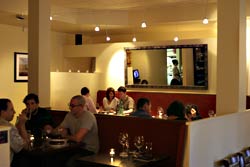It’s taken me a couple of weeks to figure out where I come down on Beàto Food & Wine, a tiny bistro on the northern stretches of California Avenue in West Seattle. Consider the conflicting evidence:
A halibut fillet, perfectly seared so that the fish melted apart, topped with only a tangle of sea beans. Halibut is to me the oatmeal of fish, creamy and soothingly bland, and this dish looked practically macrobiotic in its minimalism. Yet the oceanic, deeply vegetal seaweed turned out to be the perfect salsa for the fish, the salty crunch that illuminated its subtleties.
Then there was the chocolate mousse with peppermint-rhubarb compote. The moment my friend and I put spoon to mouth, we grimaced at each other. Who had the delusional idea that milk chocolate (think Jell-O pudding, only milder) would stand up to the clanging acid-sweet flavor of stewed rhubarb? And when this person was stirring the rhubarb and peppermint together, did he or she forget the electric-shock horror of drinking orange juice after brushing your teeth?
It’s hard to average out the A-plusses, B’s, and F’s I tasted in my two meals at six-month-old Beàto. What I like most about this neighborhood restaurant with downtown tastes is that it has a proper sense of scale. The menu is small and seasonal, the dishes interestingly conceived but simple to put together so they don’t stress a small kitchen. The Italian-focused wine list is just big and eclectic enough to make Beàto a drop-in spot for locals in search of a glass, yet small enough to prevent money-draining spoilage. Beàto’s prices are exactly what you expect of a good neighborhood restaurant—a light meal of small plates costs about $35 a person, and a full three courses with a bottle of wine adds another $25 per person to the check.
The room, also, fits its setting—small and comfortable enough to be a neighborhood place; polished enough to cater to West Seattle’s increasingly high-end class of neighbors. When he took over the restaurant, owner Brandon Gillespie knocked down a center wall and painted the more spacious room creamy, with burgundy banquettes, dark wood tables, and thick mirrors to push the space beyond its walls. There are about a dozen tables, and another 10 seats around the bar, set far enough apart that anyone who sits there doesn’t feel squinched into second class. A couple of weeks ago, Gillespie also installed a new set of wrought-iron tables on the brick patio outside, which will almost double Beàto’s seating capacity on warm nights.
And the service, on my first visit, hit exactly the right tone. Our Chicago-transplant waiter had a flourish that many Seattle servers lack. She staged the meal so smoothly that we never thought to wonder when our next bite was going to arrive. She judged the mood of the table instantly, becoming jokey but not overly informal. She upsold us so skillfully that I didn’t regret the extra cash I spent from my personal budget. (Do I normally order two $14 glasses? No, I certainly don’t, unless someone makes them both sound so perfect for the dishes I’m ordering that it’s worth the extra dollars.) The guy who waited on us during my second visit was pleasant and distracted in equal measure—so as far as Seattle goes, business as usual.
The food is where the experience gets uneven.
Gillespie has cooked all over Italy and worked for an Italian wine distributor, so it’s no surprise his chef, Nick Devine, last of the Hunt Club, has given the Pacific Northwest menu an Italian slant. (Beàto means “blessed” in Italian.) You’ll see that in the 1-ounce servings of Fra’ Mani gentile—a garlicky, artisanal salami from Oakland, sliced so thin it resembles vellum—and the bowls of creamy ricotta gnocchi tossed with slices of a roasted housemade sausage that’s as juicy as it gets.
Dishes succeeded and failed in quick succession. Sweet, earthy roasted beets, sliced paper thin, served as a secondary plate for curly, crunchy Bloomsdale spinach; linking the two together was a discreet vinaigrette and a quenelle of goat cheese mixed with roasted almonds. It was so delightful that the plate next to it on the table doubly disappointed me. The luxurious meatiness of Devine’s shredded pork belly in a circular mold was completely undercut by the dish’s own foppery—honey to sweeten it up, segments of tart grapefruit to clash with the honey, and unseasoned quinoa underneath to swallow up the flavor.
A few dishes were nondescript—an underseasoned, overcooked chicken braciola (chicken breast rolled around prosciutto and celery), a gummy risotto crowned with nowhere near enough shaved raw asparagus to lend its flavor to the rice—but mostly they were good or puzzlingly bad. The sense I got, after desserts like the rhubarb-chocolate mousse and another night’s strawberry-rhubarb shortcake (which would have been fantastic had it not been for the heap of raw, undressed sorrel leaves we were supposed to eat with it) was that the chef had taken an idea rich with possibilities and not cooked it through, tasting different versions until the concept worked.
There were enough creative dishes where it did to show what Devine could accomplish when he had done his homework. His seared St. Jude’s albacore with kalamata olives, spring-garlic puree, and roasted tomato oil offered full-bodied pleasures, and the chocolate madeleine cake layered with mascarpone and crunchy almond cocoa-nib tuiles came off as paradoxically dainty and decadent. The fact that every meal had such high points, amid the mediocre and bad ones, finally tips the balance, for me, in Beàto’s favor.






